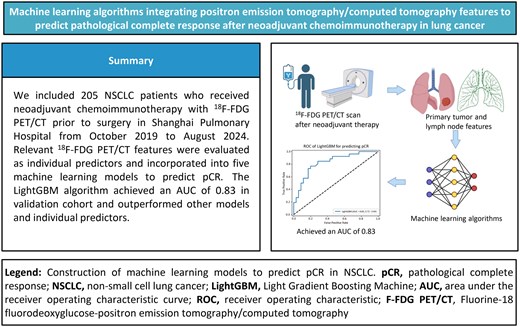-
Views
-
Cite
Cite
Zhenxin Sheng, Shuyu Ji, Yancheng Chen, Zirong Mi, Huansha Yu, Lele Zhang, Shiyue Wan, Nan Song, Ziyun Shen, Peng Zhang, Machine learning algorithms integrating positron emission tomography/computed tomography features to predict pathological complete response after neoadjuvant chemoimmunotherapy in lung cancer, European Journal of Cardio-Thoracic Surgery, Volume 67, Issue 5, May 2025, ezaf132, https://doi.org/10.1093/ejcts/ezaf132
Close - Share Icon Share
Abstract
Reliable methods for predicting pathological complete response (pCR) in non-small cell lung cancer (NSCLC) patients undergoing neoadjuvant chemoimmunotherapy are still under exploration. Although Fluorine-18 fluorodeoxyglucose-positron emission tomography/computed tomography (18F-FDG PET/CT) features reflect tumour response, their utility in predicting pCR remains controversial.
This retrospective analysis included NSCLC patients who received neoadjuvant chemoimmunotherapy followed by 18F-FDG PET/CT imaging at Shanghai Pulmonary Hospital from October 2019 to August 2024. Eligible patients were randomly divided into training and validation cohort at a 7:3 ratio. Relevant 18F-FDG PET/CT features were evaluated as individual predictors and incorporated into 5 machine learning (ML) models. Model performance was assessed using the area under the receiver operating characteristic curve (AUC), and Shapley additive explanation was applied for model interpretation.
A total of 205 patients were included, with 91 (44.4%) achieving pCR. Post-treatment tumour maximum standardized uptake value (SUVmax) demonstrated the highest predictive performance among individual predictors, achieving an AUC of 0.72 (95% CI 0.65–0.79), while ΔT SUVmax achieved an AUC of 0.65 (95% CI 0.53–0.77). The Light Gradient Boosting Machine algorithm outperformed other models and individual predictors, achieving an average AUC of 0.87 (95% CI 0.78–0.97) in training cohort and 0.83 (95% CI 0.72–0.94) in validation cohort. Shapley additive explanation analysis identified post-treatment tumour SUVmax and post-treatment nodal volume as key contributors.
This ML models offer a non-invasive and effective approach for predicting pCR after neoadjuvant chemoimmunotherapy in NSCLC.







